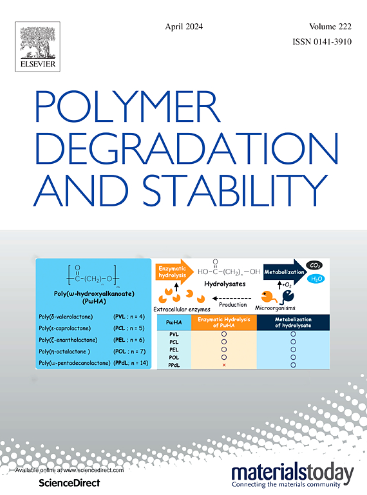Biomass-derived poly(lactic acid) and poly(3-methyl-1,5-pentanediol sebacate) alternating multiblock copolymers with improved marine biodegradability and mechanical properties
IF 6.3
2区 化学
Q1 POLYMER SCIENCE
引用次数: 0
Abstract
The reliance on fossil resources and the mismanagement of waste owing to the rapid increase in plastic production have led to serious environmental problems, particularly global marine pollution. In recent years, poly(lactic acid) (PLA) has been widely used as a biomass plastic to replace petroleum-based materials. However, the biodegradation of PLA is limited to composting environments and its brittle nature limits its application. This study aimed to synthesize a biomass-based PLA and poly(3-methyl-1,5-pentanediol sebacic acid) (PMPDSe)-diol copolymer and evaluate its marine biodegradability and mechanical properties. PLA was copolymerized with PMPDSe-diol to obtain the triblock copolymer PLA-PMPDSe-PLA, which was then chain-extended with hexamethylene diisocyanate to form an alternating multiblock (PLA-alt-PMPDSe) copolymer. Because of their regular arrangement, the thermal and mechanical properties could be controlled by varying the length of the PLA chains, compared with random multiblock (PLA-ran-PMPDSe) copolymers. In particular, when 61 % or 71 % PLA was included, the films had higher elongation at break (331 %–518 %) and toughness than PLA and PLA-ran-PMPDSe copolymers. Biodegradability was the highest when 54 % PLA was used, and the films disintegrated in compost and seawater. In seawater, the molecular weight decreased to 45 % in three months, and the biodegradability was confirmed to be >17 % in two months. Furthermore, the PLA-alt-PMPDSe copolymer exhibited a contact angle of over 83°, which is equivalent to that of PLA and could be used as a film. This polymer has a wide range of applications and will contribute to the development of sustainable bioplastics and address plastic waste.
生物质衍生的聚乳酸和聚3-甲基-1,5-戊二醇癸二酸酯交替多嵌段共聚物,具有改善的海洋生物降解性和机械性能
对矿物资源的依赖以及由于塑料生产的迅速增加而造成的废物管理不善导致了严重的环境问题,特别是全球海洋污染。近年来,聚乳酸(PLA)作为一种生物质塑料被广泛应用于替代石油基材料。然而,聚乳酸的生物降解仅限于堆肥环境,其脆性限制了其应用。本研究旨在合成生物质基聚乳酸和聚(3-甲基-1,5-戊二醇癸二酸)(PMPDSe)-二醇共聚物,并评价其海洋生物降解性和力学性能。PLA与pmpdse -二醇共聚得到三嵌段共聚物PLA- pmpdse -PLA,然后与六亚甲基二异氰酸酯进行扩链形成交替多嵌段共聚物(PLA- alpmpdse)。与随机多嵌段(PLA-ran- pmpdse)共聚物相比,由于它们的规则排列,可以通过改变PLA链的长度来控制其热性能和力学性能。特别是,当含有61%或71% PLA时,薄膜的断裂伸长率(331% - 518%)和韧性高于PLA和PLA-ran- pmpdse共聚物。当PLA用量为54%时,膜的生物降解性最高,在堆肥和海水中降解。在海水中,3个月后分子量下降到45%,2个月后生物降解率达到17%。此外,PLA-alt- pmpdse共聚物的接触角超过83°,与PLA相当,可以用作薄膜。该聚合物具有广泛的用途,将有助于可持续生物塑料的发展和塑料废物的处理。
本文章由计算机程序翻译,如有差异,请以英文原文为准。
求助全文
约1分钟内获得全文
求助全文
来源期刊

Polymer Degradation and Stability
化学-高分子科学
CiteScore
10.10
自引率
10.20%
发文量
325
审稿时长
23 days
期刊介绍:
Polymer Degradation and Stability deals with the degradation reactions and their control which are a major preoccupation of practitioners of the many and diverse aspects of modern polymer technology.
Deteriorative reactions occur during processing, when polymers are subjected to heat, oxygen and mechanical stress, and during the useful life of the materials when oxygen and sunlight are the most important degradative agencies. In more specialised applications, degradation may be induced by high energy radiation, ozone, atmospheric pollutants, mechanical stress, biological action, hydrolysis and many other influences. The mechanisms of these reactions and stabilisation processes must be understood if the technology and application of polymers are to continue to advance. The reporting of investigations of this kind is therefore a major function of this journal.
However there are also new developments in polymer technology in which degradation processes find positive applications. For example, photodegradable plastics are now available, the recycling of polymeric products will become increasingly important, degradation and combustion studies are involved in the definition of the fire hazards which are associated with polymeric materials and the microelectronics industry is vitally dependent upon polymer degradation in the manufacture of its circuitry. Polymer properties may also be improved by processes like curing and grafting, the chemistry of which can be closely related to that which causes physical deterioration in other circumstances.
 求助内容:
求助内容: 应助结果提醒方式:
应助结果提醒方式:


